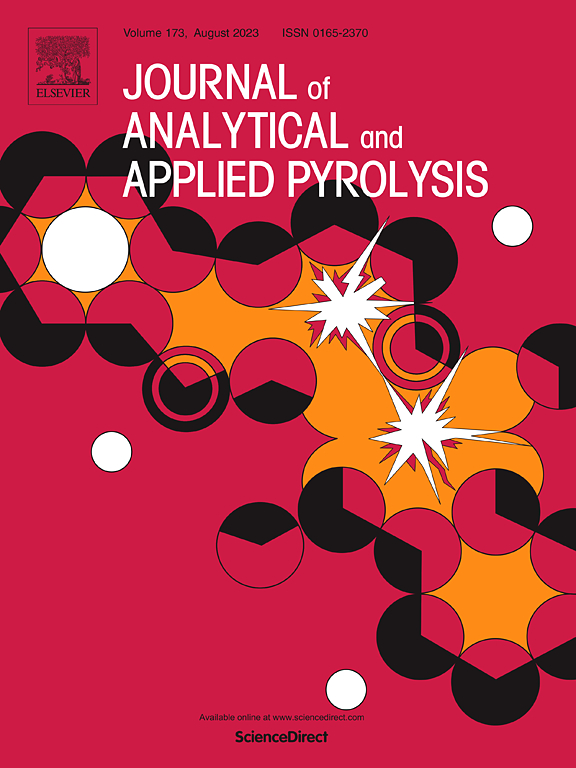Catalytic fast co-pyrolysis of lignocellulosic biomass and polypropylene over bimetallic catalysts to promote the formation of hydrocarbons
IF 6.2
2区 化学
Q1 CHEMISTRY, ANALYTICAL
引用次数: 0
Abstract
Lignocellulosic biomass is considered a renewable resource with great potential to replace fossil energy, which has a relatively low effective H/Ceff ratio. As a result, its thermochemical conversion products are of low calorific value and quality. Polypropylene (PP) is rich in hydrogen and contains little oxygen. Catalytic fast co-pyrolysis (co-CFP) of cotton stalks (CS) and PP significantly improved bio-oil quality. It enables the efficient and clean utilization of CS and PP, while enhancing the concentration of BTEX (Benzene, toluene, ethylbenzene, xylene) and other liquid hydrocarbons in bio-oil. In this study, bimetallic catalysts are prepared by alkali-modified HZSM-5 and zirconium dioxide (ZrO2) loaded with Ni and Mo, respectively. The impact of different ratios on the product is explored, revealing their synergistic effects in the co-CFP process. XRD, XPS, TEM, and other methods characterize the morphology and physicochemical properties of the catalysts. The co-CFP of CS and PP by Py-GC/MS and thermogravimetric experiments is investigated. The experimental conditions were as follows: pyrolysis temperature of 600 °C, raw material mixing ratio of 1:1, and feedstock-to-catalyst ratio of 1:1. In the catalytic stage, when the Ni:Mo ratio was set to 2:1, the relative hydrocarbon content in the Ni-Mo/ZrO2 catalyst reached a maximum value (75.2 %) at Ni:Mo= 2:1. The relative hydrocarbon content initially decreased and then increased with decreased Ni/Mo ratio and reached the minimum at 1:2. The relative hydrocarbon content in the Ni-Mo/HZSM-5 catalyst reaches a maximum value (60.9 %) at Ni:Mo= 2:1. Ni-Mo/HZSM-5 catalyst has more substantial selectivity for aromatic hydrocarbons. The synergistic effect between metals is explored using reaction kinetics based on thermogravimetric experiments. Based on thermogravimetric experiments, the synergistic effects between metals were analyzed using reaction kinetics. Specifically, this involves effectively reducing the activation energy of the reaction, thereby promoting the formation of hydrocarbons. For the NiMo/ZrO2 catalyst, the activation energy generally decreases with increasing Mo content (from 38.51 to 29.47 kJ/mol). In contrast, when HZSM-5 is used as the support material, the activation energy decreases with increasing Mo loading and decreasing Ni loading (from 12.31 to 8.43 kJ/mol). The right amount of metal loading introduces the catalyst's active site, and the synergy between the metals further improves the bio-oil quality. The activation energy is lowest when Ni:Mo = 2:1. The change trend is consistent with the content of hydrocarbons.
木质纤维素生物质与聚丙烯在双金属催化剂上催化快速共热解以促进碳氢化合物的生成
木质纤维素生物质被认为是一种可再生资源,具有取代化石能源的巨大潜力,而化石能源的有效H/Ceff比相对较低。因此,其热化学转化产品具有低热值和高质量。聚丙烯(PP)含有丰富的氢和很少的氧。棉秆与PP催化快速共热解(co-CFP)显著提高了生物油的品质。实现了CS和PP的高效清洁利用,同时提高了生物油中BTEX(苯、甲苯、乙苯、二甲苯)等液态烃的浓度。本研究采用碱改性HZSM-5和二氧化锆(ZrO2)分别负载Ni和Mo制备了双金属催化剂。探讨了不同比例对产品的影响,揭示了它们在co-CFP过程中的协同效应。通过XRD、XPS、TEM等方法表征催化剂的形貌和理化性质。采用Py-GC/MS和热重实验对CS和PP的共cfp进行了研究。实验条件为:热解温度600℃,原料混合比1:1,原料催化剂比1:1。在催化阶段,当Ni:Mo比为2:1时,Ni-Mo/ZrO2催化剂中相对烃含量在Ni:Mo= 2:1时达到最大值(75.2 %)。相对烃含量随Ni/Mo比的减小先减小后增大,在1:2时达到最小值。Ni-Mo/HZSM-5催化剂中相对烃含量在Ni:Mo= 2:1时达到最大值(60.9 %)。Ni-Mo/HZSM-5催化剂对芳烃具有较强的选择性。利用热重实验的反应动力学方法探讨了金属间的协同效应。在热重实验的基础上,利用反应动力学分析了金属间的协同效应。具体来说,这涉及到有效地降低反应的活化能,从而促进碳氢化合物的形成。对于NiMo/ZrO2催化剂,随着Mo含量的增加,活化能普遍降低(从38.51 ~ 29.47 kJ/mol)。而以HZSM-5为载体材料时,活化能随Mo加载量的增加和Ni加载量的减小而减小(从12.31降至8.43 kJ/mol)。适量的金属负载引入了催化剂的活性位点,金属之间的协同作用进一步提高了生物油的质量。当Ni:Mo = 2:1时活化能最低。其变化趋势与烃类含量的变化趋势一致。
本文章由计算机程序翻译,如有差异,请以英文原文为准。
求助全文
约1分钟内获得全文
求助全文
来源期刊
CiteScore
9.10
自引率
11.70%
发文量
340
审稿时长
44 days
期刊介绍:
The Journal of Analytical and Applied Pyrolysis (JAAP) is devoted to the publication of papers dealing with innovative applications of pyrolysis processes, the characterization of products related to pyrolysis reactions, and investigations of reaction mechanism. To be considered by JAAP, a manuscript should present significant progress in these topics. The novelty must be satisfactorily argued in the cover letter. A manuscript with a cover letter to the editor not addressing the novelty is likely to be rejected without review.

 求助内容:
求助内容: 应助结果提醒方式:
应助结果提醒方式:


